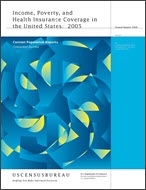Income, Poverty, and Health Insurance Coverage in the United States: 2005
Income, Poverty, and Health Insurance Coverage in the United States: 2005
Introduction
This report presents data on income, poverty, and health insurance coverage in the United States based on information collected in the 2006 and earlier Annual Social and Economic Supplements (ASEC) to the Current Population Survey (CPS) conducted by the U.S. Census Bureau.1
Real median household income increased between 2004 and 2005.2 Both the number of people in poverty and the poverty rate were not statistically different between 2004 and 2005. The number of people with health insurance coverage increased, while the percentage of people with health insurance coverage decreased between 2004 and 2005. Both the number and the percentage of people without health insurance coverage increased between 2004 and 2005. These results were not uniform across demographic groups. For example, the poverty rate for non-Hispanic Whites decreased, while the overall rate was statistically unchanged.3
This report has three main sections—income, poverty, and health insurance coverage. Each one presents estimates by characteristics such as race, Hispanic origin, nativity, and region. Other topics include earnings of year-round, full-time workers; poverty among families; and health insurance coverage of children. This report also contains data by metropolitan area status, which were not included last year due to the transition from a 1990-based sample design to a 2000-based sample design. This year, the report uses a new system of metropolitan categorization. The data are now presented as inside metropolitan statistical areas, inside principal cities, outside principal cities, and outside metropolitan statistical areas. The report concludes with a section discussing health insurance coverage by state using 2- and 3-year averages.
The income and poverty estimates shown in this report are based solely on money income before taxes and do not include the value of noncash benefits such as food stamps, Medicare, Medicaid, public housing, and employer-provided fringe benefits. Later this year, the Census Bureau will release detailed tables on alternative measures of income and poverty, which include taxes and selected noncash benefits.
The CPS is one of the longest-running surveys conducted by the Census Bureau. The CPS ASEC asks detailed questions categorizing income into over 50 sources. The key purpose of the CPS ASEC is to provide timely and detailed estimates of income, poverty, and health insurance coverage and to measure change in those estimates at the national level. The CPS ASEC is the official source of the national poverty estimates calculated in accordance with the Office of Management and Budget (OMB) Statistical Policy Directive 14 (Appendix B).
__________
1 This year’s report reflects some changes to the 2005 ASEC data due to a correction to the sample weights made after the publication of last year’s report. In addition to the weighting correction, the health insurance data from the 2005 ASEC were revised to reflect improvements to the algorithm that assigns coverage to dependents.
2 All income values are adjusted to reflect2005 dollars. “Real” refers to income after adjusting for inflation. The adjustment is based on percentage changes in prices between earlier years and 2005 and is computed by dividing the annual average Consumer Price Index Research Series for 2005 by the annual average for earlier years. The CPI-U-RS values for 1947 to 2005 are available in Appendix A and on the Internet at <www.census.gov/hhes/www/income/income05/cpiurs.html>. Inflation between 2004 and 2005 was 3.3 percent.
3 Federal surveys now give respondents the option of reporting more than one race. Therefore, two basic ways of defining a race group are possible. A group such as Asian may be defined as those who reported Asian and no other race (the race-alone or single-race concept) or as those who reported Asian regardless of whether they also reported another race (the race-alone-or-in-combination concept). The body of this report (text, figures, and tables) shows data using the first approach (race alone). The appendix tables show data using both approaches. Use of the single-race population does not imply that it is the preferred method of presenting or analyzing data. The Census Bureau uses a variety of approaches.
All comparative statements regarding race in the text are based on the race-alone concept and, unless noted to the contrary, are also true in terms of statistical significance for the race-alone-or-in-combination concept.
In this report, the term “non-Hispanic White” refers to people who are not Hispanic and who reported White and no other race. The Census Bureau uses non-Hispanic Whites as the comparison group for other race groups and Hispanics.
Because Hispanics may be any race, data in this report for Hispanics overlap with data for racial groups. Being Hispanic was reported by 12.1 percent of White householders who reported only one race, 2.9 percent of Black householders who reported only one race, 27.7 percent of American Indian and Alaska Native householders who reported only one race, and 9.5 percent of Native Hawaiian and Other Pacific Islander householders who reported only one race.
Source Information
Income and Poverty Tables
Health Insurance Tables (as published in August 2006)
NOTE: The 2004 and 2005 data have been revised since originally published. Please see user note for more information.
Selected Revised Health Insurance Tables
Income & Poverty Visualizations
Health Insurance Visualizations
Income & Poverty Detailed Tables
Table
Table
Table
Health Insurance Detailed Tables
Table
Table
Income & Poverty Historical Tables
Table
Table
Table
Table
Table
Table
Table
Table
Health Insurance Historical Tables - HIA
Others in Series
Publication
Publication
Publication









